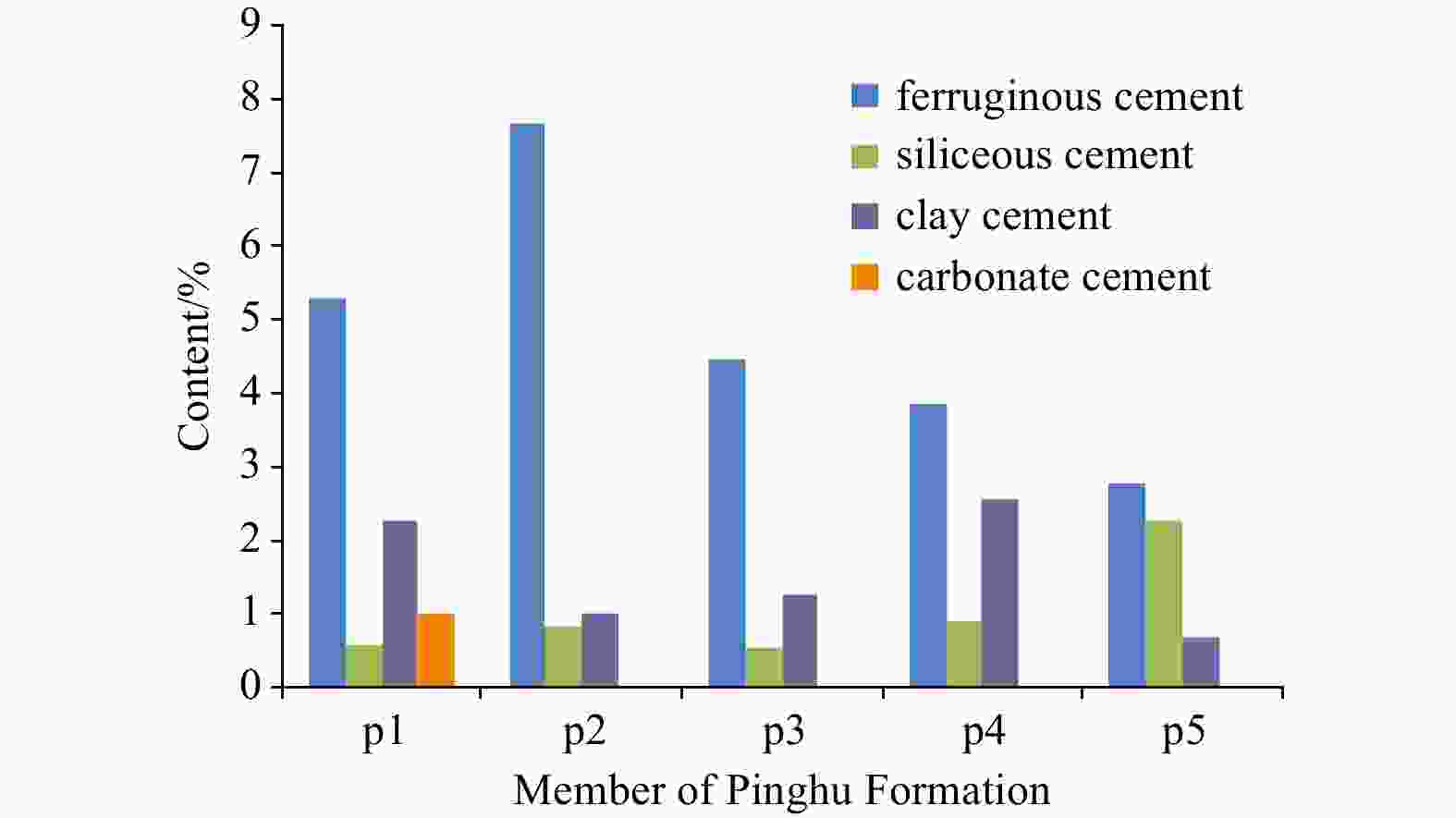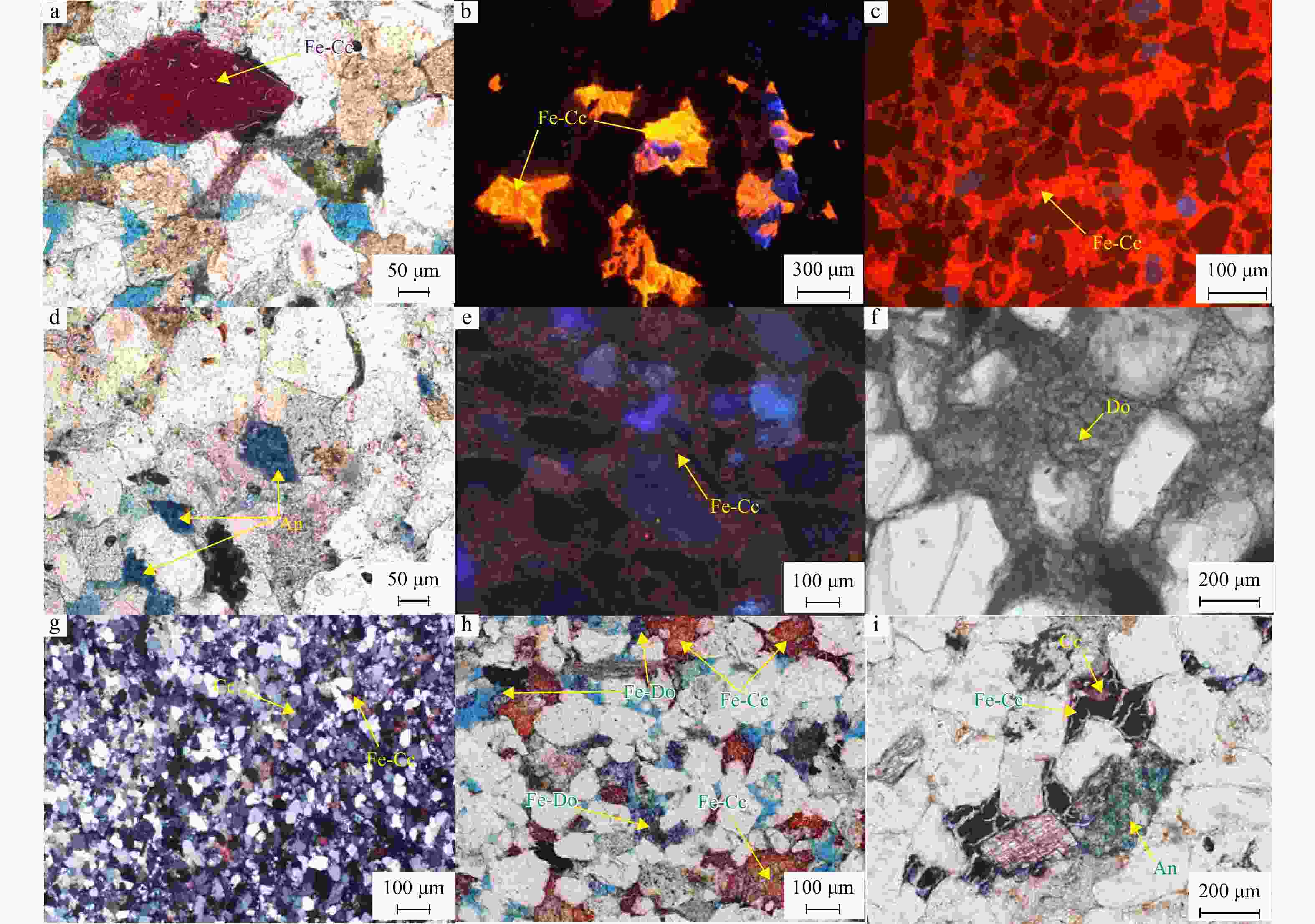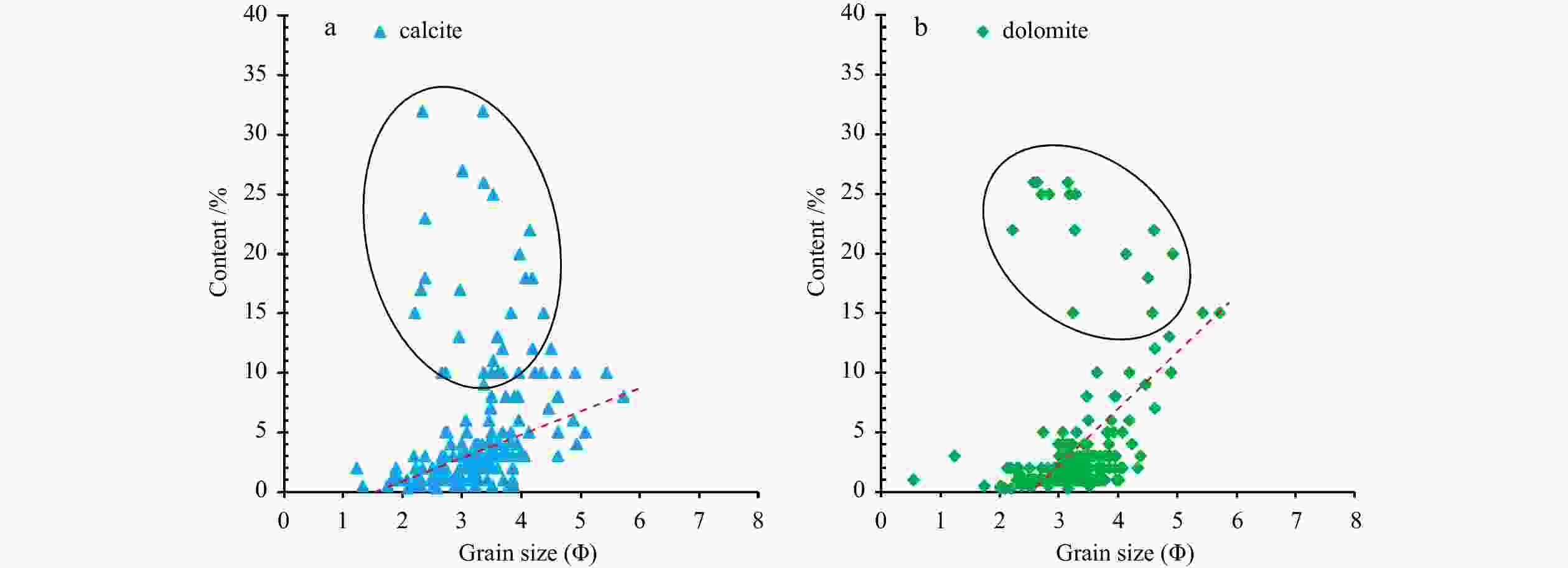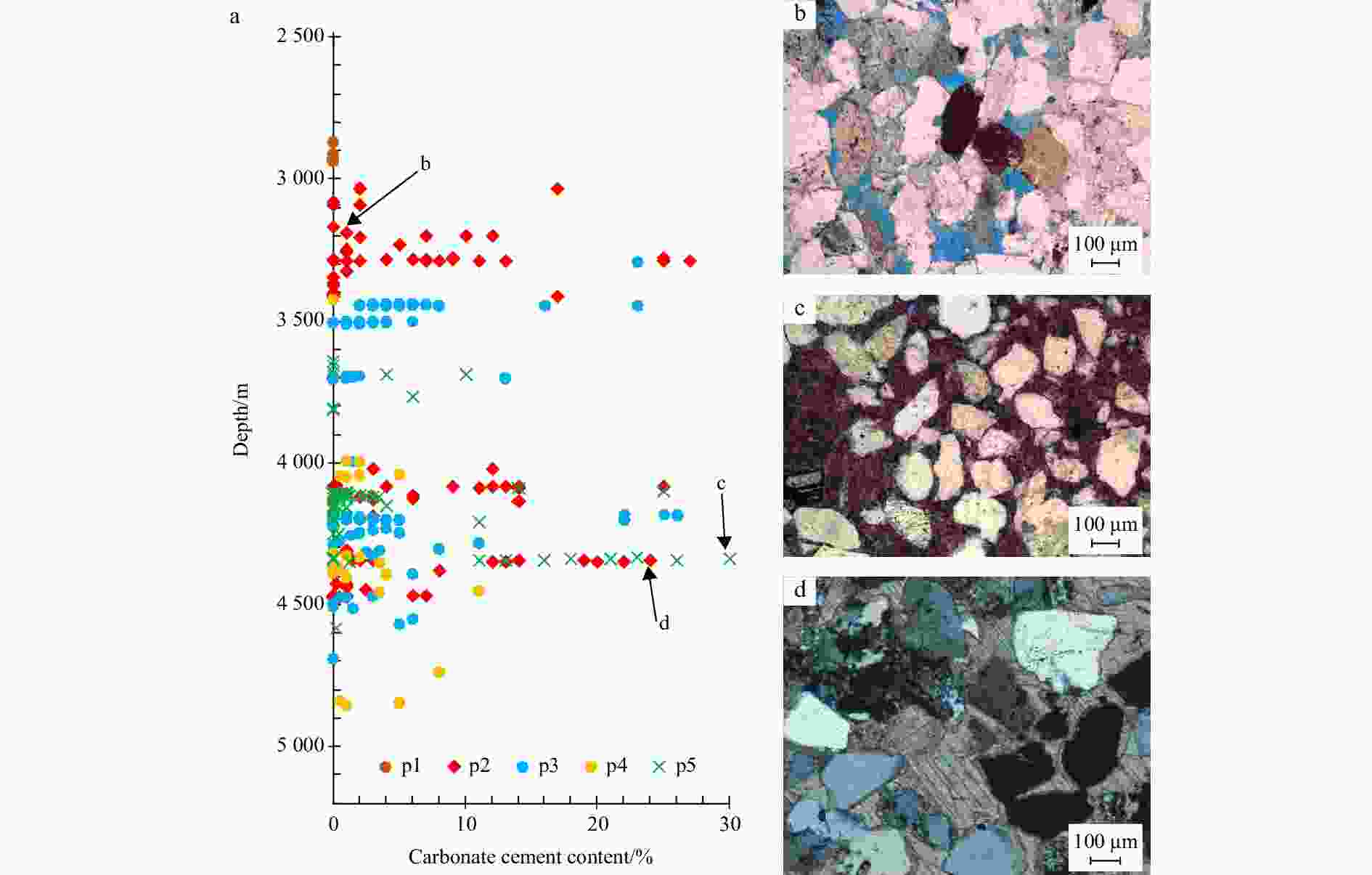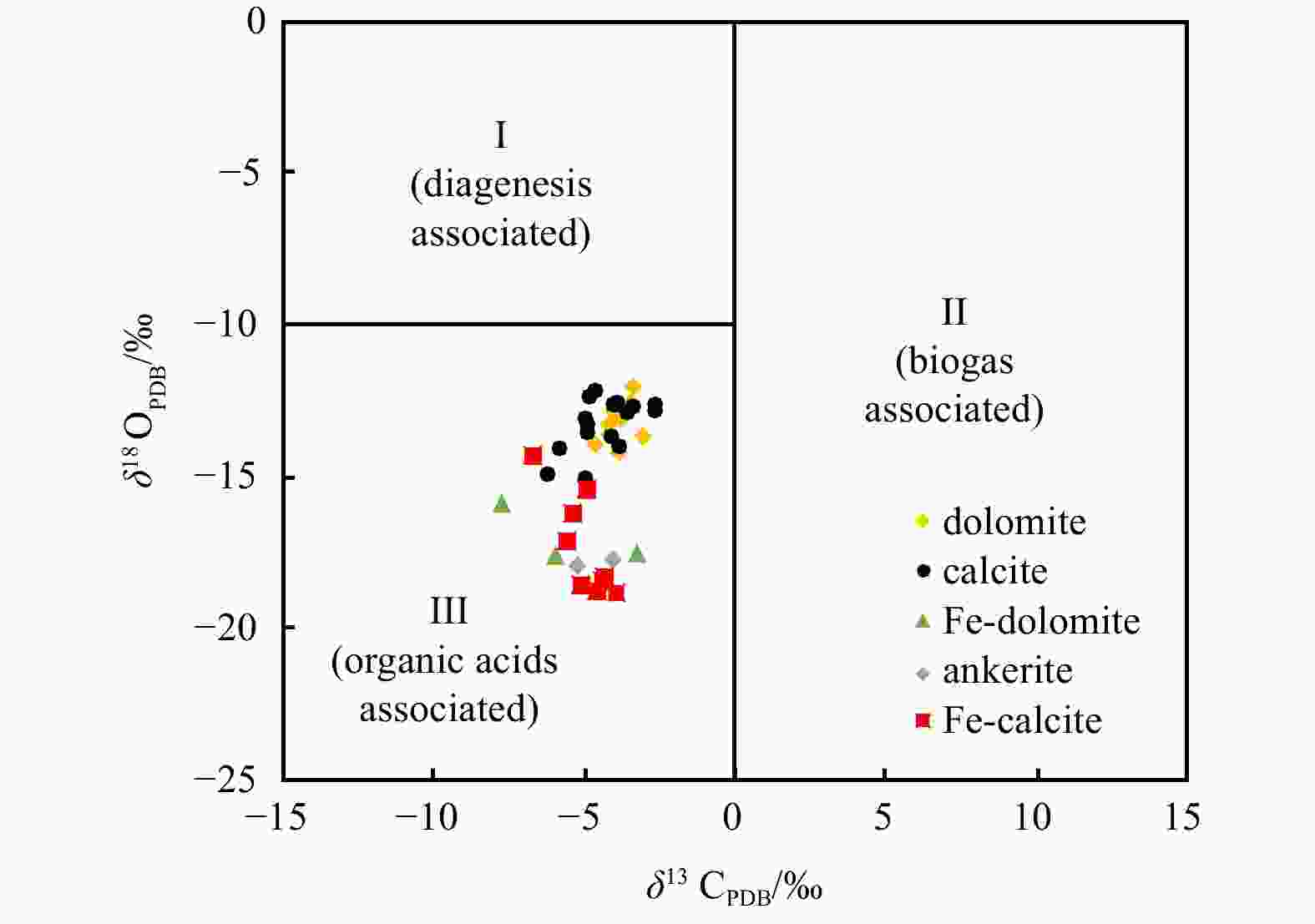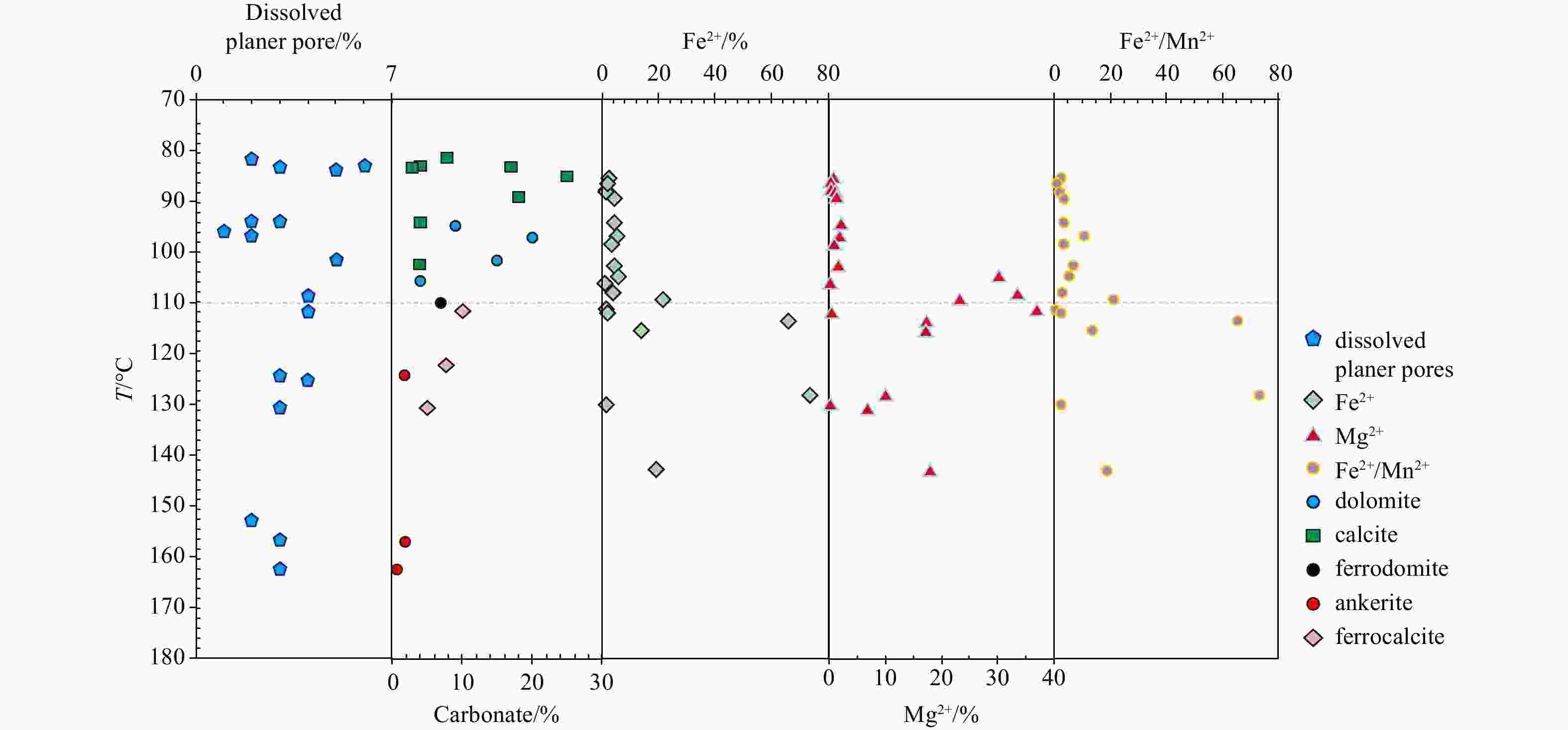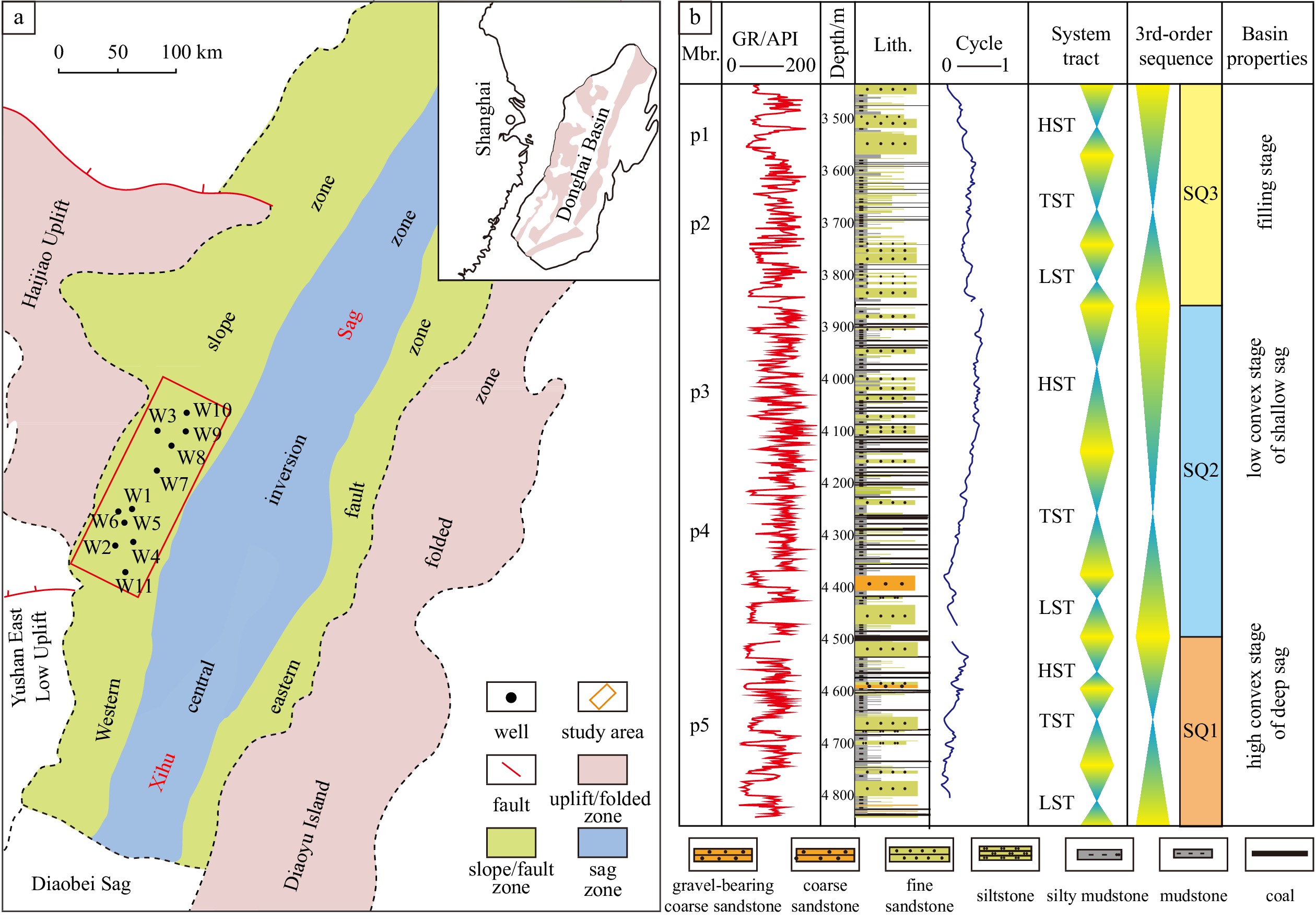Mechanism of carbonate cementation and its influence on reservoir in Pinghu Formation of Xihu Sag
-
Abstract: Carbonate cements are the most abundant authigenic mineral and impact on physical properties greatly in sandstone reservoir. In this paper, Pinghu Formation of Xihu Sag was taken as a target. Characteristics, distribution and formation of carbonate cements were investigated via optical microscopy, cathodoluminescence (CL), electron probe and in-situ carbon-oxygen isotope. The results showed that carbonate cements varied in types and shapes. Calcite/dolomite mainly present as poikilotopic cements, while ferrocalcite/ferrodolomite/ankerite generally present as pore-filling cements. Carbon isotope (δ13C) values of carbonate cements were ranging from –7.77‰ to –2.67‰, with an average of –4.52‰, while oxygen isotope (δ18O) values were ranging from –18.94‰ to –12.04‰, with an average of –14.86‰. The δ13C/δ18O indicated that the paleo-fluid of carbonate cement was mainly freshwater. Organic carbon mainly came from organic matter within mature source rocks, and inorganic carbon came from dissolution of carbonate debris and early carbonate cements. Distinctive δ13C/δ18O values manifest that carbonate cements with different types formed in different periods, which make different contributions to the reservoir properties. Calcite/dolomite formed during eodiagenesis (70–90℃) and early mesodiagenesis stage (90–120℃), and were favorable to reservoir owing to their compacted resistance and selective dissolution. Ferrocalcite/ferrodolomite/ankerite formed during middle-late mesodiagenetic stage (above 120℃), and were unfavorable to reservoir due to cementing the residual intergranular pores. Hence, in order to evaluate the reservoir characteristics, it is of significantly important to distinguish different types of carbonate cements and explore their origins.
-
Key words:
- carbonate cements /
- genesis mechanism /
- Xihu Sag /
- Pinghu Formation
-
Figure 1. Tectonic belt in Xihu Sag and stratigraphic sequence in the study area. a is modified after Shanghai Company of China National Offshore Oil Corporation (CNOOC), and the red rectangle in a is the study area. b is the comprehensive column map from of the study area. Mbr.: member; GR: gamma Ray; API: American Petroleum Institute; Lith.: lithology; HST: highstand system tract; TST: transgressive system tract; LST: lowstand system tract.
Figure 3. Characteristics of carbonate cements in Pinghu Formation. a. W1, 3439.47 m, p3, ferrocalcite terrestrial carbonate fragment or intraclast limestone (yellow arrow) (plane-polarized light); b. W2, 4 297.1 m, p1, cathodoluminescence feature of pore filling cementation calcite (yellow arrow) (CL); c. W3, 4 206.77 m, p5, cathodoluminescence feature of poikilotopic cementation Calcite (yellow arrow) (CL); d. W1, 3439.57 m, p3, ferrodolomite filling residual intergranular pores (yellow arrow) (plane-polarized light); e. W4, 4019.9 m, p2, cathodoluminescence feature of grain-embedded ferrocalcite (yellow arrow) (CL); f. W4, 4202.87 m, p3, dolomite filled intergranular pore(yellow arrow) (CL); g. W5, 4086.9 m, p2, calcite and ferrocalcite staining characteristics in siltstone (yellow arrow) (plane-polarized light); h. W6, 4247 m, p3, pore filling cementation ferrocalcite, ferrodolomite filling intergranular pores or terrestrial carbonate fragment or intraclast limestone (yellow arrows) (plane-polarized light); i. W7, 3754 m, p3, calcite replaced by ferrocalcite, ferrodolomite replaced by ferrocalcite (plane-polarized light). An: ankerite; Cc: calcite; Do: dolomite; CL: cathode luminescence.
Figure 5. CaO-FeO-MgO classification of carbonate cements (I: calcite, II: Fe calcite, III: dolomite, IV: Fe dolomite, V: ankerite, adapted from Liu et al., 2011).
Figure 7. Distribution characteristics of carbonate cements. a. Distribution of carbonate cements in different layers of Pinghu Formation with depth; b. W1, 3 444.67 m, p3, granular ferrocalcite replaced debris particles (plane-polarized light); c. W1, 3447.27 m, p3, poikilotopic cementation ferrocalcite (plane-polarized light); d. W4, 4202.77 m, p3, poikilotopic cementation ferrocalcite (plane-polarized light). The locations of sampling points of b, c and d are shown in a.
Figure 8. Genesis type diagram of carbonate cement in Pinghu Formation (modified after Wang and Zhao, 2001).
Figure 10. Relationship between carbonate cements and physical properties. a. The cross plot diagram of (Fe) calcite content and porosity; b. the cross plot diagram of (Fe) calcite content and permeability; c. the cross plot diagram of (Fe) dolomite/ankerite content and porosity; d. the cross plot diagram of (Fe) dolomite/ankerite content and permeability.
Table 1. Results of carbon and oxygen isotope in carbonate cement of Pinghu Formation
Well name Member Depth/m Carbonate minerals $\text{δ} $13CPDB/‰ $\text{δ} $18OPDB/‰ Z Diagenesis temperature/℃ T1 T2 T3 Average W8 p5 4339.23 calcite –4.16 –13.67 112.0 77.8 112.5 173.9 121.4 W8 p5 4342.89 calcite –3.96 –12.64 112.9 57.2 83.4 118.7 86.4 W8 p5 4340.89 calcite –3.58 –12.87 113.6 58.7 85.1 120.7 88.2 W8 p5 4342.89 ferrocalcite –5.16 –18.59 107.5 100.0 132.5 175.1 135.9 W8 p5 4340.89 ferrocalcite –4.62 –18.75 108.5 101.2 133.9 176.7 137.3 W8 p5 4342.89 dolomite –4.25 –13.56 111.8 76.9 111.5 172.7 120.4 W3 p3 4219.26 calcite –4.65 –12.21 111.7 54.6 80.3 115.1 83.3 W3 p3 4196.05 calcite –4.06 –12.61 112.7 57.0 83.2 118.5 86.2 W3 p3 4196.55 calcite –3.95 –12.57 113.0 56.8 82.8 118.1 85.9 W9 p1–p2 4344.79 calcite –6.25 –14.94 107.1 88.8 125.2 188.5 134.2 W9 p1–p2 4345.59 calcite –5.85 –14.06 108.3 66.5 94.2 131.2 97.3 W9 p1–p2 4348.69 calcite –5.02 –13.11 110.5 60.2 86.9 122.8 90.0 W9 p1–p2 4348.69 calcite –4.96 –15.06 109.6 73.4 102.1 140.5 105.3 W9 p1–p2 4344.79 calcite –4.95 –13.57 110.4 76.9 111.5 172.8 120.4 W9 p1–p2 4348.69 calcite –4.91 –13.27 110.6 74.4 108.7 169.4 117.5 W9 p1–p2 4345.09 calcite –3.41 –12.68 114.0 57.5 83.7 119.1 86.8 W9 p1–p2 4348.69 ferrocalcite –6.76 –14.30 106.3 68.2 96.1 133.5 99.2 W9 p1–p2 4344.79 ferrocalcite –5.64 –17.11 107.2 109.0 148.2 214.7 157.3 W9 p1–p2 4348.69 ferrocalcite –4.35 –18.34 109.3 97.9 130.1 172.5 133.5 W10 p1–p2 4471.2 ankerite –4.96 –18.42 108.0 122.0 162.9 231.3 172.1 W7 p1–p2 4397.54 calcite –3.87 –14.01 112.4 66.2 93.8 130.8 97.0 W7 p1–p2 4394.11 calcite –2.67 –12.67 115.5 57.4 83.6 119.0 86.7 W7 p1–p2 4406.85 ferrocalcite –4.42 –18.41 109.1 98.5 130.8 173.2 134.2 W7 p1–p2 4397.54 ferrocalcite –3.95 –18.82 109.8 101.8 134.5 177.4 137.9 W7 p1–p2 4394.51 ferrodolomite –5.98 –17.56 106.3 113.4 153.2 220.3 162.3 W7 p1–p2 4394.51 ferrodolomite –3.30 –17.53 111.8 113.1 152.9 220.0 162.0 W11 p5 4565.43 ferrocalcite –5.42 –16.21 108.1 81.7 111.7 151.4 114.9 W11 p5 4565.43 ferrocalcite –4.97 –15.42 109.4 76.0 105.1 143.8 108.3 W1 p3 3439.87 calcite –2.69 –12.81 115.4 58.3 84.6 120.2 87.7 W1 p3 3447.38 dolomite –4.08 –12.79 112.6 70.5 104.1 164.2 112.9 W1 p3 3447.38 dolomite –3.81 –13.07 113.0 72.7 106.7 167.2 115.5 W1 p3 3447.07 dolomite –3.51 –12.54 113.9 68.4 101.7 161.4 110.5 W1 p3 3447.38 dolomite –3.40 –12.04 114.3 64.4 97.0 156.0 105.8 W1 p3 3447.38 dolomite –3.08 –13.67 114.2 77.8 112.6 173.9 121.4 W1 p3 3443.07 ankerite –5.28 –17.90 107.6 116.8 157.0 224.7 166.2 W1 p3 3439.47 ankerite –4.08 –17.70 110.1 92.9 124.4 166.0 127.8 W5 p2–p3 4085.85 calcite –4.84 –12.40 111.2 55.7 81.6 116.6 84.6 W5 p2–p3 4093.45 dolomite –4.67 –13.91 110.8 79.9 114.9 176.6 123.8 W5 p2–p3 4084.28 dolomite –4.20 –13.26 112.1 74.4 108.6 169.3 117.4 W5 p2–p3 4085.26 dolomite –3.92 –14.18 112.2 67.3 95.1 132.3 98.2 W5 p2–p3 4086.56 ferrodolomite –7.77 –15.90 103.5 79.4 109.0 148.4 112.3 W5 p2–p3 4084.28 ankerite –4.68 –18.94 108.3 127.3 168.9 238.1 178.1 Note: T1 is the temperature when the fluid is meteoric water ($\text{δ}^{18} {\rm{O}}_{{\rm{Water}}}({\rm{SMOW}}) $=–5‰), T2 is the temperature when the fluid is pleistocene ice age water ($\text{δ}^{18} {\rm{O}}_{{\rm{Water}}}({\rm{SMOW}}) $=–1.2‰), and T3 is the temperature at which the fluid is formation water ($\text{δ}^{18} {\rm{O}}_{{\rm{Water}}}({\rm{SMOW}}) $=2‰). -
Carothers W W, Adami L H, Rosenbauer R J. 1988. Experimental oxygen isotope fractionation between siderite-water and phosphoric acid liberated CO2-siderite. Geochimica et Cosmochimica Acta, 52(10): 2445–2450. doi: 10.1016/0016-7037(88)90302-X Chen Sizhong. 2003. Main geological characteristics and gas exploration directions in East China Sea Basin. China Offshore Oil and Gas (Geology) (in Chinese), 17(1): 6–13,19 Duan Wei, Luo Chengfei, Liu Jianzhang, et al. 2015. Effect of overpressure formation on reservoir diagenesis and its geological significance to LD block of Yinggehai Basin. Earth Science (in Chinese), 40(9): 1517–1528 Han Wuying, Lin Hongying, Cai Yanya. 1996. Study on the carbon flux in the South China Sea. Acta Oceanologica Sinica, 15(1): 85–92 Hao Lewei, Wang Qi, Guo Ruiliang, et al. 2018. Diagenetic fluids evolution of Oligocene Huagang Formation sandstone reservoir in the south of Xihu Sag, the East China Sea Shelf Basin: constraints from petrology, mineralogy, and isotope geochemistry. Acta Oceanologica Sinica, 37(2): 25–34. doi: 10.1007/s13131-017-1126-8 Hao Lewei, Wang Qi, Liao Peng. 2011. Forming mechanism of secondary porosity in tertiary reservoirs in Panyu Low Uplift and North Slope of Baiyun Sag. Acta Sedimentologica Sinica (in Chinese), 29(4): 734–743 He Sheng, Yang Zhi, He Zhiliang, et al. 2009. Mechanism of carbonate cementation and secondary dissolution porosity formation in deep-burial sandstones near the top overpressured surface in central part of Junggar Basin. Earth Science-Journal of China University of Geosciences (in Chinese), 34(5): 759–768,798. doi: 10.3799/dqkx.2009.084 Jiang Yiming, Shao Longyi, Li Shuai, et al. 2020. Deposition system and stratigraphy of Pinghu Formation in Pinghu Tectonic Belt, Xihu Sag. Geoscience (in Chinese), 34(1): 141–153 Keith M L, Weber J N. 1964. Carbon and oxygen isotopic composition of selected limestones and fossils. Geochimica et Cosmochimica Acta, 28(10/11): 1787–1816 Li Zengxue, Zhang Gongcheng, Li Ying, et al. 2012. The Paleogene coal-bearing basin and coal-measures distribution of China Sea area. Earth Science Frontiers (in Chinese), 19(4): 314–326 Liu Sibing, Huang Sijing, Shen Zhongmin, et al. 2014. Diagenetic fluid evolution and water-rock interaction model of carbonate cements in sandstone: An example from the reservoir sandstone of the Fourth Member of the Xujiahe Formation of the Xiaoquan-Fenggu area, Sichuan Province, China. Science China Earth Sciences, 57(5): 1077–1092. doi: 10.1007/s11430-014-4851-2 Liu Chengdong, Zhang Shoupeng, Liu Ting, et al. 2011. Chemical composition and isotopic characteristics of the carbonate cements in sandstone reservoir layer of Dongying sinking. Procedia Earth and Planetary Science, 2: 284–290. doi: 10.1016/j.proeps.2011.09.045 Lu Huan, Xu Changgui, Wang Qingbin, et al. 2019. Genetic mechanism of carbonate cements and its impact on the Mesozoic clastic reservoir quality of the C12 and Q17 structures, Bohai Sea Area. Oil and Gas Geology (in Chinese), 40(6): 1270–1280 O’Neil J R, Clayton R N, Mayeda T K. 1969. Oxygen isotope fractionation in divalent metal carbonates. The Journal of Chemical Physics, 51(12): 5547–5558. doi: 10.1063/1.1671982 Shen Jian. 2020. Carbonate cementation characteristics and genetic mechanism of tight sandstone reservoirs in Longdong area, Ordos Basin. Lithologic Reservoirs (in Chinese), 32(2): 24–32 Wang Daifu, Luo Jinglan, Chen Shuhui, et al. 2017. Carbonate cementation and origin analysis of deep sandstone reservoirs in the Baiyun Sag, Pearl River Mouth Basin. Acta Geologica Sinica (in Chinese), 91(9): 2079–2090 Wang Qingbin, Zang Chunyan, Lai Weicheng, et al. 2009. Distribution characteristics and origin of carbonate cements in the middle and deep clastic reservoirs of the Paleogene in the Bozhong Depression. Oil and Gas Geology (in Chinese), 30(4): 438–443 Wang Yongxin, Zhao Chenglin. 2001. Characters of deep-buried clastic reservoir rocks in Hexiwu structural belt of Langgu depression. Oil and Gas Geology (in Chinese), 22(2): 119–122 Wang Tong, Zhu Xiaomin, Liu Yu et al. 2021. Characteristics and significance of carbonate cements in member 3 of Shahejie formation in the northern subsag of Laizhouwan Sag. Geological Journal of China Universities (in Chinese), 27(5): 526–535 Wang Qi, Zhuo Xizhun, Chen Guojun, et al. 2007. Characteristics of carbon and oxygen isotopic compositions of carbonate cements in Triassic Yanchang sandstone in Ordos Basin. Natural Gas Industry (in Chinese), 27(10): 28–32 Wei Wei, Zhu Xiaomin, Guo Dianbin, et al. 2015. Carbonate cements in Lower Cretaceous Bayingebi sandstone reservoirs in Chagan Sag, Yin-e Basin: Formation phases and formation mechanisms. Geochimica (in Chinese), 44(6): 590–599 Xiao Xiaoguang, Qin Lanzhi, Zhang Wu, et al. 2021. The origin of carbonate cements and the influence on reservoir quality of Pinghu Formation in Xihu Sag. Chinese Journal of Geology (in Chinese), 56(4): 1062–1076 Yang Pengcheng, Liu Feng, Shen Shan, et al. 2020. A study on the hydrocarbon generation potential of the coal-bearing source rocks in the Pinghu Formation of Pingbei area, the Xihu Depression. Marine Geology and Quaternary Geology (in Chinese), 40(4): 139–147 Yao Jingli, Wang Qi, Zhang Rui, et al. 2011. Origin and spatial distribution of carbonate cements in Yanchang Fm. (Triassic) sandstones within the lacustrine center of Ordos Basin, NW China. Natural Gas Geoscience (in Chinese), 22(6): 943–950 Zhang Xiulian. 1985. Relationship between carbon and oxygen stable isotope in carbonate rocks and paleosalinity and paleotemperature of seawater. Acta Sedimentologica Sinica (in Chinese), 3(4): 17–30 Zhang Qingqing, Liu Keyu, Liu Taixun, et al. 2021. Research status of the genesis of carbonate cementation in clastic reservoirs. Marine Origin Petroleum Geology (in Chinese), 26(3): 231–244 Zhang Gongcheng, Miao Shunde, Chen Ying, et al. 2013. Distribution of gas enrichment regions controlled by source rocks and geothermal heat in China offshore basins. Natural Gas Industry (in Chinese), 33(4): 1–17 Zhang Minqiang, Xu Fa, Zhang Jianpei, et al. 2011. Structural pattern during the rifting stage of the Xihu Sag and its control of sediment infilling. Marine Geology and Quaternary Geology (in Chinese), 31(5): 67–72. doi: 10.3724/SP.J.1140.2011.05067 Zhang Zhiyao, Zhang Changmin, Hou Guowei, et al. 2020. Microfacies distribution and sedimentary model of Pinghu Formation in P well area, East China Sea basin. Geology and Resources (in Chinese), 29(2): 142–151, 160 Zhao Xiaoqing, Bao Zhidong, Meng Yuanlin, et al. 2013. Distribution of carbonate cements in the Members 3 and 4 of Lower Cretaceous Quantou Formation of northern Songliao Basin and its main controling factors. Journal of Palaeogeography (in Chinese), 15(1): 125–134 Zheng Junmao, Ying Fengxiang. 1997. Reservoir characteristics and diagenetic model of sandstone intercalated in coal-bearing strata (acid water medium). Acta Petrolei Sinica (in Chinese), 18(4): 19–24 Zhou Xinhuai. 2020. Geological understanding and innovation in Xihu sag and breakthroughs in oil and gas exploration. China Offshore Oil and Gas, 32(1): 1–12 Zhu Erqin. 1986. Characteristics and origin of calcareous concretions in the Huanghai and the East China Seas. Acta Oceanologica Sinica, 5(1): 99–107 Zhuo Xizhun, Wang Qi, Li Juan, et al. 2013. Influence of early carbonate cementation on porosity evolution of sandstones in the Zhujiang Formation, Enping Sag, Pearl River Mouth Basin. Natural Gas Industry (in Chinese), 33(4): 26–30 Zou Mingliang, Huang Sijing, Hu Zuowei, et al. 2008. The origin of carbonate cements and the influence on reservoir quality of Pinghu Formation in Xihu Sag, East China Sea. Lithologic Reservoirs (in Chinese), 20(1): 47–52 -




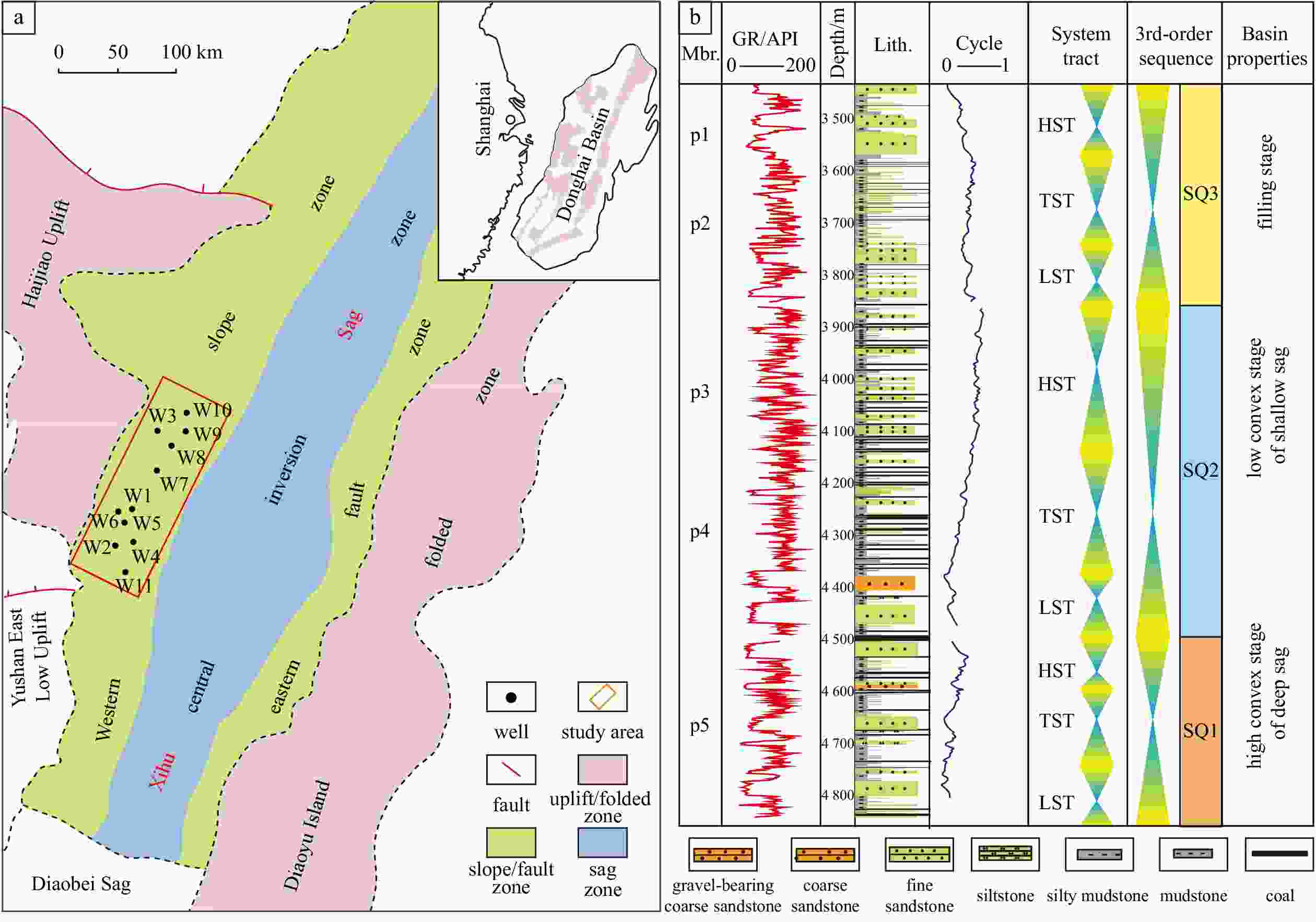
 下载:
下载:
